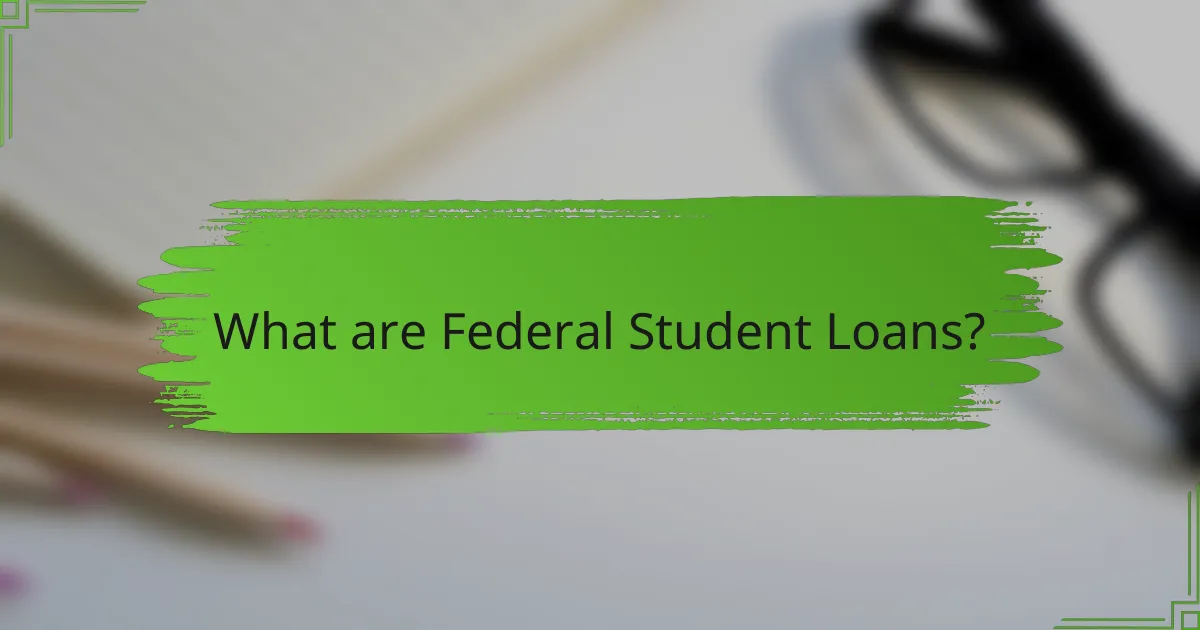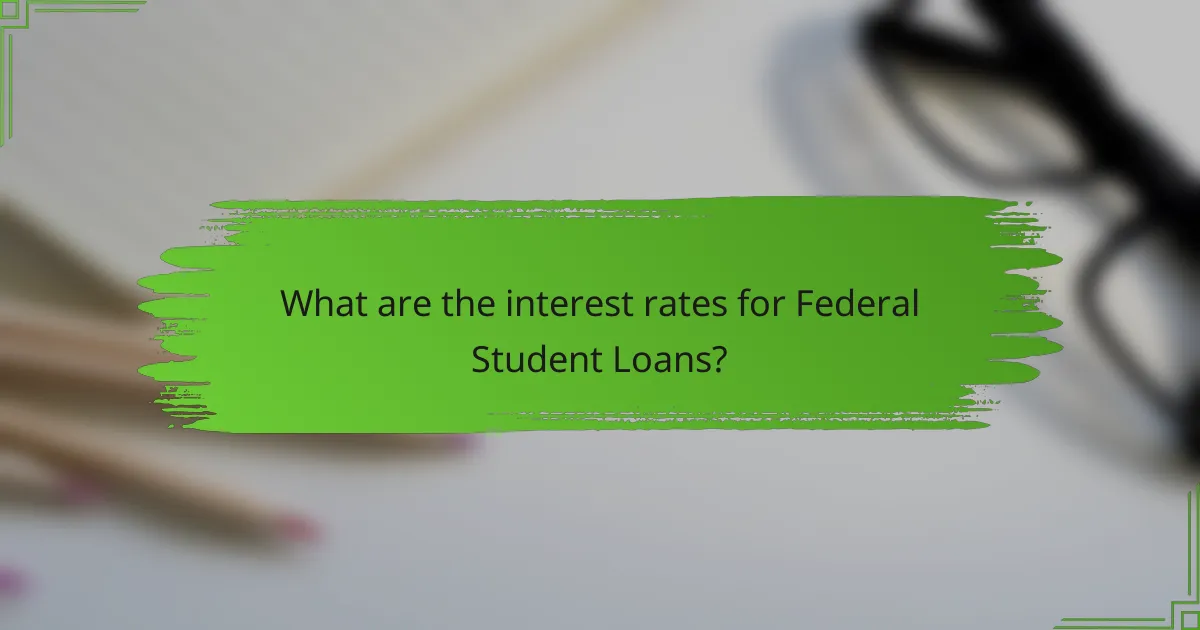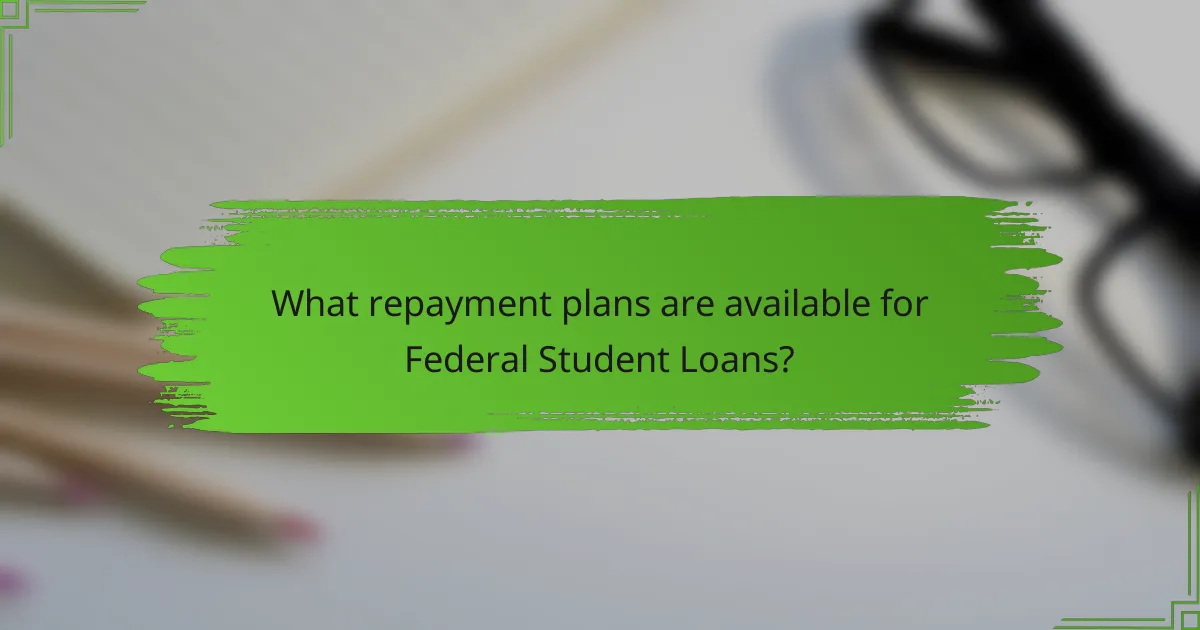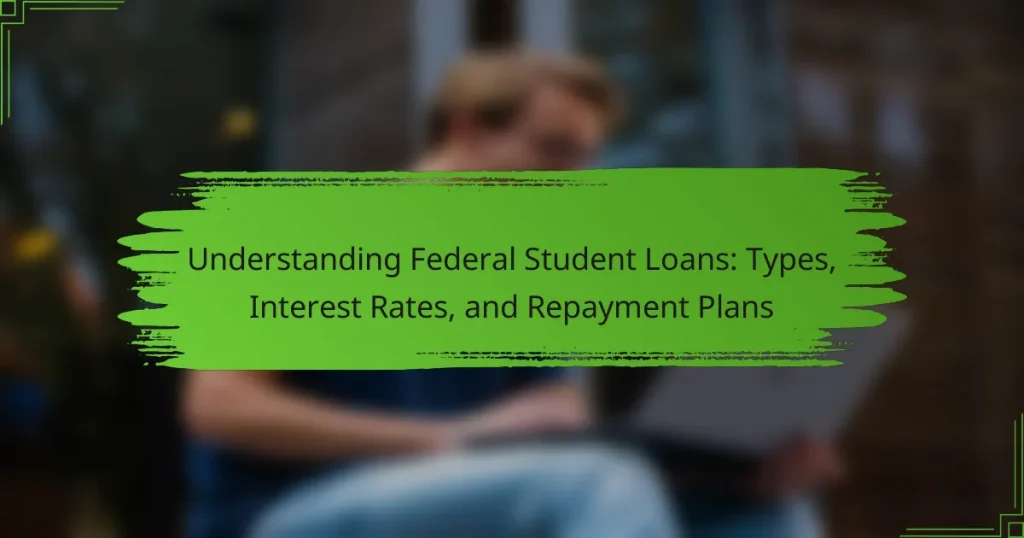
What are Federal Student Loans?
Federal student loans are loans provided by the federal government to help students pay for their education. These loans typically offer lower interest rates compared to private loans. They come with flexible repayment options and benefits, such as income-driven repayment plans. Federal student loans include Direct Subsidized Loans, Direct Unsubsidized Loans, and Direct PLUS Loans. Subsidized loans are based on financial need, while unsubsidized loans are available regardless of need. Interest on subsidized loans does not accrue while the student is in school. Federal student loans also offer deferment and forbearance options in case of financial hardship. According to the U.S. Department of Education, over 42 million borrowers hold federal student loans.
How do Federal Student Loans differ from private loans?
Federal student loans are issued by the government, while private loans are provided by private lenders. Federal loans typically offer lower interest rates compared to private loans. Federal loans come with flexible repayment options and deferment options based on financial need. Private loans often require a credit check and may have stricter eligibility criteria. Additionally, federal loans may provide borrower protections such as income-driven repayment plans and loan forgiveness programs. In contrast, private loans generally lack these borrower protections. Federal loans also have fixed interest rates, while private loans can have variable rates that may increase over time.
What are the key characteristics of Federal Student Loans?
Federal Student Loans are government-funded loans designed to help students pay for their education. They typically offer lower interest rates compared to private loans. Federal loans do not require a credit check for most types. They also provide flexible repayment options, including income-driven repayment plans. Additionally, they offer deferment and forbearance options for borrowers facing financial difficulties. Federal loans may qualify for loan forgiveness programs, such as Public Service Loan Forgiveness. They include different types, such as Direct Subsidized and Direct Unsubsidized Loans. These loans are available to undergraduate and graduate students, as well as parents of dependent students.
Why might borrowers choose Federal Student Loans over private options?
Borrowers might choose Federal Student Loans over private options due to favorable terms and protections. Federal loans typically offer lower interest rates compared to private loans. They also provide flexible repayment plans, including income-driven repayment options. Additionally, federal loans come with benefits like deferment and forbearance during financial hardship. Borrowers can access loan forgiveness programs that are not available with private loans. Federal loans do not require a credit check, making them accessible to a wider range of students. These factors contribute to the preference for federal loans among borrowers.
What types of Federal Student Loans are available?
There are four main types of Federal Student Loans available. These include Direct Subsidized Loans, Direct Unsubsidized Loans, Direct PLUS Loans, and Direct Consolidation Loans.
Direct Subsidized Loans are for undergraduate students with demonstrated financial need. The government pays the interest while the student is in school.
Direct Unsubsidized Loans are available to undergraduate and graduate students. They do not require financial need, and interest accrues while the student is in school.
Direct PLUS Loans are for graduate or professional students and parents of dependent undergraduate students. They require a credit check and can cover the full cost of education.
Direct Consolidation Loans allow borrowers to combine multiple federal loans into one. This simplifies repayment by providing a single monthly payment.
What are Direct Subsidized Loans and how do they work?
Direct Subsidized Loans are federal student loans for undergraduate students with demonstrated financial need. These loans are offered by the U.S. Department of Education. The government pays the interest on these loans while the borrower is in school at least half-time. This benefit helps reduce the overall cost of the loan. Repayment begins six months after graduation or when the student drops below half-time enrollment. The maximum loan amount varies based on the student’s year in school and dependency status. For the 2023-2024 academic year, the interest rate for Direct Subsidized Loans is fixed at 5.50%. This type of loan is part of the Direct Loan Program, which aims to provide affordable financing for education.
What are Direct Unsubsidized Loans and who can apply for them?
Direct Unsubsidized Loans are federal student loans that are not based on financial need. Borrowers are responsible for paying the interest that accrues during all periods. These loans are available to undergraduate and graduate students. To apply, students must complete the Free Application for Federal Student Aid (FAFSA). There are no specific income requirements to qualify for these loans. Eligibility is based on enrollment in an eligible program at a college or university. Direct Unsubsidized Loans can help cover the cost of education. They are part of the Direct Loan Program managed by the U.S. Department of Education.
What are Direct PLUS Loans and what eligibility criteria must be met?
Direct PLUS Loans are federal loans designed for graduate or professional students and parents of dependent undergraduate students. These loans help cover education costs that exceed other financial aid. To be eligible for a Direct PLUS Loan, applicants must meet specific criteria. They must be enrolled at least half-time in an eligible program. A credit check is required, and applicants should not have an adverse credit history. Additionally, they must be a U.S. citizen or eligible non-citizen. They also need to complete the Free Application for Federal Student Aid (FAFSA). Finally, they must meet any other requirements set by the school.
What are Direct Consolidation Loans and how can they benefit borrowers?
Direct Consolidation Loans are a type of federal student loan that allows borrowers to combine multiple federal loans into one. This process simplifies repayment by merging loans into a single monthly payment. Borrowers can benefit from a fixed interest rate based on the average of their existing loans. This can lead to lower monthly payments and extended repayment terms, making it more manageable. Additionally, consolidation can restore eligibility for certain repayment plans and forgiveness programs. According to the U.S. Department of Education, borrowers may also benefit from deferment or forbearance options after consolidation.

What are the interest rates for Federal Student Loans?
The interest rates for Federal Student Loans vary based on the loan type and the disbursement year. For the 2023-2024 academic year, the interest rates are as follows: Direct Subsidized Loans and Direct Unsubsidized Loans have a fixed rate of 5.50%. Direct PLUS Loans for parents and graduate students have a fixed rate of 7.54%. These rates are set annually and can change each academic year. The U.S. Department of Education publishes these rates, ensuring transparency and consistency for borrowers.
How are interest rates determined for Federal Student Loans?
Interest rates for Federal Student Loans are determined by federal legislation. Specifically, the rates are set by the Higher Education Act. Each year, the interest rate is calculated based on the 10-year Treasury note auction. The rate is fixed for the life of the loan once disbursed. For undergraduate loans, the rate is capped at 2.05% above the yield of the 10-year Treasury note. Graduate loans have a higher cap at 3.6% above the yield. This method ensures that rates reflect current market conditions. The U.S. Department of Education publishes the rates annually.
What is the difference between fixed and variable interest rates?
Fixed interest rates remain constant throughout the loan term. This means borrowers pay the same interest amount each month. Variable interest rates can fluctuate over time. These rates are typically tied to an index, leading to potential changes in monthly payments. Fixed rates provide predictability and stability. Variable rates may offer lower initial costs but carry risks of increasing payments. Historical data shows that fixed rates are less likely to change unexpectedly, while variable rates can lead to significant cost variations over time.
How do interest rates impact the overall cost of borrowing?
Interest rates directly affect the overall cost of borrowing. Higher interest rates increase the total amount repaid over the loan’s term. For example, a loan of $10,000 at a 5% interest rate results in $1,500 in interest over ten years. Conversely, a 10% interest rate would increase that interest to $5,000. This demonstrates that a higher rate significantly raises borrowing costs. Additionally, interest rates influence monthly payment amounts. Higher rates lead to larger monthly payments, impacting borrowers’ budgets. Therefore, understanding interest rates is crucial for managing loan expenses effectively.
What are the current interest rates for different types of Federal Student Loans?
The current interest rates for different types of Federal Student Loans are as follows: Direct Subsidized Loans have an interest rate of 4.99%. Direct Unsubsidized Loans also have an interest rate of 4.99%. Direct PLUS Loans for parents and graduate students have an interest rate of 7.54%. These rates are applicable for loans disbursed during the 2023-2024 academic year. The interest rates are set annually by the federal government and are based on the 10-year Treasury note.
How do the interest rates for Direct Subsidized and Unsubsidized Loans compare?
Direct Subsidized Loans and Unsubsidized Loans have the same interest rates. For the 2023-2024 academic year, both types of loans have a fixed interest rate of 5.50%. This rate applies to loans disbursed during this period. The interest rates for these loans are set by the federal government. They are reviewed annually and can change based on the 10-year Treasury note. However, the comparison remains consistent as both loan types share the same rate for the specified academic year.
What are the interest rates for PLUS Loans and how do they differ from other loans?
The interest rate for PLUS Loans is fixed at 7.54% for the 2023-2024 academic year. This rate is higher than the rates for federal Direct Subsidized and Unsubsidized Loans, which are 5.50% and 4.99%, respectively. PLUS Loans are specifically designed for parents of dependent undergraduate students and graduate or professional students. Unlike other federal loans, PLUS Loans require a credit check. Borrowers with adverse credit history may be denied, whereas other federal loans do not have this requirement. Additionally, there is no limit on the amount that can be borrowed through PLUS Loans, unlike other federal loans that have specific borrowing limits.

What repayment plans are available for Federal Student Loans?
Federal Student Loans offer several repayment plans. The Standard Repayment Plan requires fixed payments over ten years. The Graduated Repayment Plan starts with lower payments that increase every two years. The Extended Repayment Plan allows for fixed or graduated payments over up to 25 years. Income-Driven Repayment Plans adjust payments based on income and family size. These include the Income-Based Repayment Plan, Pay As You Earn Plan, and Revised Pay As You Earn Plan. Each plan has specific eligibility criteria and benefits.
What are the standard repayment options for Federal Student Loans?
The standard repayment options for Federal Student Loans include the Standard Repayment Plan, Graduated Repayment Plan, Extended Repayment Plan, and Income-Driven Repayment Plans. The Standard Repayment Plan typically requires fixed monthly payments over 10 years. The Graduated Repayment Plan starts with lower payments that increase every two years, also over 10 years. The Extended Repayment Plan allows borrowers to extend payments up to 25 years, with fixed or graduated options. Income-Driven Repayment Plans adjust monthly payments based on income and family size. These options provide flexibility to accommodate different financial situations.
How does the Standard Repayment Plan work?
The Standard Repayment Plan requires borrowers to make fixed monthly payments over a period of 10 years. Payments are calculated based on the total loan amount and the interest rate. Each payment is the same amount, which helps with budgeting. The plan is designed to ensure that loans are paid off within the designated timeframe. Borrowers may pay less interest overall compared to other plans. This repayment option is available for most federal student loans. It is the default repayment plan for federal loans. Borrowers can switch to different repayment plans if needed.
What is the Graduated Repayment Plan and how does it function?
The Graduated Repayment Plan is a federal student loan repayment option. It starts with lower monthly payments that gradually increase over time. Typically, payments increase every two years. The plan spans a maximum of 10 years. This structure allows borrowers to manage their finances during early career stages. As income grows, payments adjust to reflect increased earnings. The total amount paid over the life of the loan may be higher than other plans. Borrowers should assess their financial situation before choosing this option.
What income-driven repayment plans are offered?
The income-driven repayment plans offered include Income-Based Repayment (IBR), Pay As You Earn (PAYE), Revised Pay As You Earn (REPAYE), and Income-Contingent Repayment (ICR). IBR caps monthly payments at a percentage of discretionary income. PAYE also limits payments based on income and family size, typically at 10%. REPAYE has a similar structure but applies to all borrowers, regardless of when loans were taken out. ICR adjusts payments based on income and can be used for Parent PLUS loans. Each plan offers forgiveness after a set period of qualifying payments, usually 20 to 25 years.
How does the Income-Based Repayment Plan (IBR) work?
The Income-Based Repayment Plan (IBR) adjusts monthly student loan payments based on income and family size. Borrowers pay 10% to 15% of their discretionary income towards loans. Discretionary income is defined as the difference between adjusted gross income and 150% of the poverty guideline for the borrower’s state. Payments are capped at the standard repayment amount for a 10-year plan. After 20 or 25 years of qualifying payments, any remaining loan balance may be forgiven. IBR is available to federal student loan borrowers who demonstrate financial hardship. This plan helps make student loan repayment more manageable for those with lower incomes.
What is the Pay As You Earn (PAYE) Plan and who qualifies for it?
The Pay As You Earn (PAYE) Plan is a federal student loan repayment option. It allows borrowers to pay a percentage of their discretionary income towards their loans. Specifically, borrowers pay 10% of their discretionary income. Payments are capped at the amount they would pay under a standard 10-year repayment plan. The PAYE Plan also offers loan forgiveness after 20 years of qualifying payments. To qualify for the PAYE Plan, borrowers must demonstrate a partial financial hardship. This typically means that their federal student loan payments exceed a certain percentage of their income. Additionally, only certain types of federal loans are eligible, including Direct Loans. Borrowers must also be new borrowers as of October 1, 2007, and must have received a disbursement of a Direct Loan on or after October 1, 2011.
What are the features of the Revised Pay As You Earn (REPAYE) Plan?
The Revised Pay As You Earn (REPAYE) Plan features income-driven repayment based on the borrower’s discretionary income. Payments are generally capped at 10% of this income. The plan offers forgiveness after 20 years for undergraduate loans and 25 years for graduate loans. Interest subsidies are provided, covering half of the unpaid interest during certain periods. Borrowers may qualify regardless of when they took out their loans. REPAYE is available for federal Direct Loans, including Direct Subsidized and Unsubsidized Loans. It also allows for spousal income consideration, which can affect payment amounts. The plan is designed to make repayment more manageable for borrowers with fluctuating incomes.
What are the benefits of choosing an income-driven repayment plan?
An income-driven repayment plan adjusts monthly student loan payments based on income and family size. This plan can lower payments to as low as 10% to 20% of discretionary income. It provides financial relief during periods of lower earnings. Borrowers may qualify for loan forgiveness after 20 or 25 years of qualifying payments. Additionally, these plans can prevent default by making payments more manageable. They also offer access to deferment and forbearance options in financial hardship situations. According to the U.S. Department of Education, approximately 7 million borrowers are enrolled in income-driven repayment plans, highlighting their popularity and effectiveness.
How can income-driven repayment plans provide financial relief for borrowers?
Income-driven repayment plans provide financial relief for borrowers by adjusting monthly payments based on income and family size. These plans typically cap payments at a percentage of discretionary income, often around 10-20%. This makes payments more manageable for borrowers with lower incomes. Moreover, if borrowers remain in these plans for a specified period, they may qualify for loan forgiveness on any remaining balance. For example, after 20-25 years of qualifying payments, borrowers can have their loans forgiven under certain plans. This structure helps prevent financial strain and keeps borrowers from defaulting on their loans. Additionally, income-driven repayment plans can also offer temporary relief through deferment or forbearance options during financial hardships.
What happens to loan forgiveness under these plans?
Loan forgiveness under these plans may be available depending on specific criteria. For example, income-driven repayment plans can lead to forgiveness after 20 to 25 years of qualifying payments. The Public Service Loan Forgiveness program offers forgiveness after 120 qualifying payments for eligible public service employees. Changes in policies may affect eligibility and terms of forgiveness. Recent legislation has aimed to streamline the process and expand access to forgiveness options. Borrowers should review their specific plan details to understand the implications for loan forgiveness.
What tips should borrowers consider when managing Federal Student Loans?
Borrowers should consider several tips when managing Federal Student Loans. First, they should understand their loan types and terms. Federal loans include Direct Subsidized, Direct Unsubsidized, and PLUS loans. Each type has different interest rates and repayment options.
Next, borrowers should create a budget that includes their loan payments. This helps ensure they can meet their financial obligations. They should also explore repayment plans. Options include Standard, Graduated, and Income-Driven Repayment plans.
Additionally, borrowers should take advantage of deferment or forbearance if they face financial difficulties. This can temporarily suspend payments without harming their credit.
Finally, borrowers should stay informed about their loans. Regularly checking their loan servicer’s website can provide updates on balances and payment history. Keeping communication open with the loan servicer is essential for managing loans effectively.
Federal student loans are government-issued loans designed to assist students in financing their education, featuring lower interest rates and flexible repayment options compared to private loans. The article covers the various types of federal student loans, including Direct Subsidized, Direct Unsubsidized, Direct PLUS, and Direct Consolidation Loans, highlighting their unique attributes and eligibility criteria. Additionally, it discusses current interest rates, repayment plans such as Standard, Graduated, and Income-Driven options, and the benefits of these plans, including potential loan forgiveness. Understanding these aspects is crucial for borrowers to effectively manage their federal student loans and make informed financial decisions.




